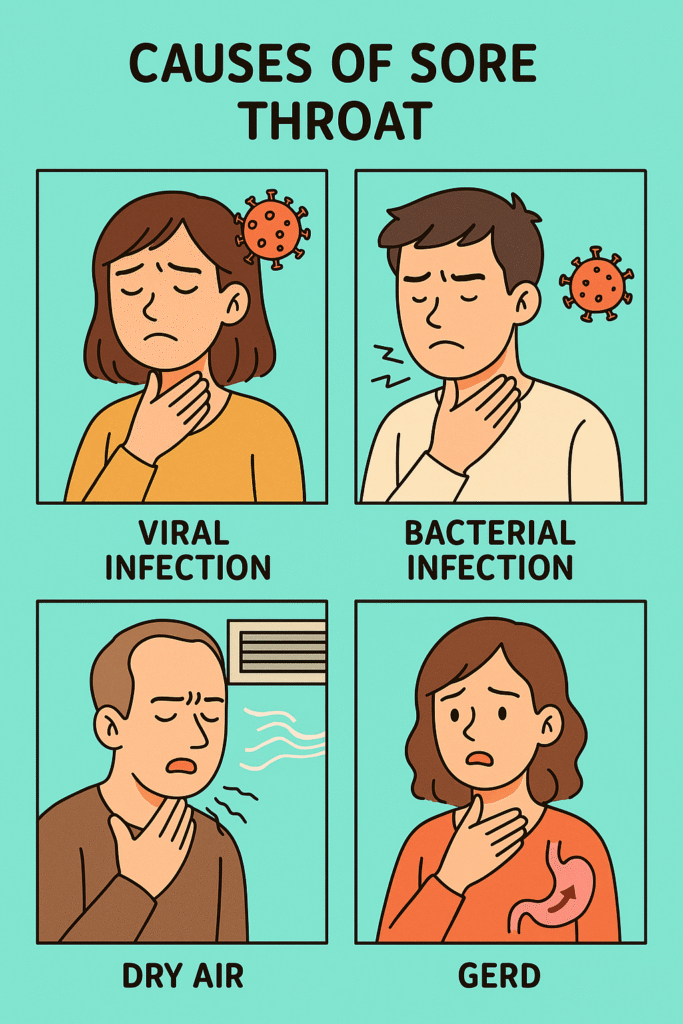We’ve all been there. You wake up, try to swallow, and—ouch! Your throat feels raw, scratchy, or like you’ve swallowed sandpaper. A sore throat might seem like a small problem, but when it hits, it can ruin your whole day.
Let’s take a closer look at what causes a sore throat, how to spot it early, and what you can do to feel better fast.
What is a Sore Throat?
A sore throat is pain, irritation, or scratchiness in the throat that often worsens when you swallow. It’s one of the most common symptoms people experience—especially during flu season or after being around someone sick.
- It affects people of all ages.
- Around 10–30% of all doctor visits for upper respiratory infections involve a sore throat.
- Most sore throats are not serious and go away on their own within a few days.
How Does a Sore Throat Happen?
Imagine your throat as a hallway lined with sensitive skin. When viruses or bacteria attack, or when that hallway gets dry or overused (like from yelling or dry air), the lining becomes inflamed. That’s when it starts to feel sore.
This inflammation—known as pharyngitis—is your body’s way of fighting off trouble. Think of it as the red flag that your immune system is on the job.
What Causes a Sore Throat?
A sore throat can be caused by several things. Here’s a quick overview:
🦠 Viral infections – About 70–90% of sore throats
- Common cold (rhinovirus)
- Influenza (flu)
- COVID-19
- Mononucleosis (caused by Epstein-Barr virus)
These don’t usually need antibiotics. Your immune system will take care of them with time, rest, and fluids.
🧫 Bacterial infections – Around 10–30%, especially in children
- The most common is Streptococcus pyogenes, causing “strep throat.”
- These can cause white patches on the tonsils, fever, and swollen glands.
Bacterial sore throats often need antibiotics to clear up and prevent complications.
🌬️ Other causes:
- Allergies (pollen, dust, pets)
- Dry air, especially from heaters
- Irritants like smoke or pollution
- Straining your voice (shouting, singing)
- Gastroesophageal reflux disease (GERD) – when stomach acid comes up into the throat

Who’s Most at Risk?
Anyone can get a sore throat, but some people are more likely to suffer from it.
- Children and teenagers – more likely to get strep throat
- People with allergies
- Smokers or those exposed to smoke
- People with weakened immune systems
- Those in close-contact environments – like schools or daycare
Other Symptoms to Watch For
Sore throat rarely comes alone. Here are some common friends it brings along:
Common symptoms:
- Scratchy or painful throat
- Pain when swallowing
- Swollen glands in the neck
- Hoarse voice
- Red or swollen tonsils
When it gets worse:
- High fever
- Difficulty swallowing or breathing
- Pus or white patches on tonsils
- Rash (with strep)
- Persistent sore throat over a week
If these severe signs show up, it’s a good idea to see a doctor.
How is a Sore Throat Diagnosed?
If your sore throat is mild and comes with a runny nose or cough, chances are it’s viral. But if you have high fever, no cough, or swollen tonsils, the doctor might suspect strep throat.
The gold standard test is the:
🧪 Throat Swab Test
- A quick swab is taken from the back of your throat.
- Results may come back in minutes (rapid test) or 1–2 days (lab culture).
- Helps determine if bacteria are the cause, and if you need antibiotics.
How Do You Treat a Sore Throat?
Most sore throats get better on their own. But while your body does the healing, here’s how you can stay comfortable:
⭐ Main Treatment:
- For viral sore throat: Rest, fluids, pain relief (paracetamol or ibuprofen), and warm liquids
- For bacterial sore throat: Antibiotics prescribed by your doctor, usually for 10 days
🧴 Other helpful options:
- Saltwater gargle – ½ teaspoon of salt in warm water
- Lozenges or throat sprays
- Warm teas with honey (avoid honey in children under 1)
- Cool-mist humidifier to moisten dry air
When Should You See a Doctor?
Call your doctor if:
- Your sore throat lasts more than a week
- You have trouble breathing or swallowing
- You see pus or white patches
- You have a rash or joint pain
- Your voice is hoarse for more than 2 weeks
Final Thoughts
A sore throat can sneak up on you after a cold day out or a long night of cheering. Most of the time, it’s nothing to worry about. But paying attention to how it feels—and how long it sticks around—can help you spot when it’s time to get help.
Stay hydrated, rest up, and treat your throat kindly.
References
- Sore Throat (Pharyngitis) – Centers for Disease Control and Prevention (CDC), updated May 2022. https://www.cdc.gov/groupastrep/diseases-public/strep-throat.html
- Sore Throat – Mayo Clinic, 2023. https://www.mayoclinic.org/diseases-conditions/sore-throat/symptoms-causes/syc-20351635
- Sore Throat – NHS – National Health Service UK, updated February 2024. https://www.nhs.uk/conditions/sore-throat/
